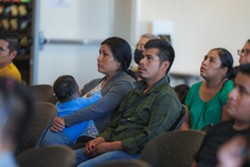[{
"name": "Newsletter Promo",
"id": "NewsletterPromo",
"class": "inlineCenter",
"insertPoint": "4",
"component": "15264767",
"requiredCountToDisplay": "0"
},{
"name": "Ad - Medium Rectangle CC01 - 300x250",
"id": "AdMediumRectangleCC01300x250",
"class": "inlineCenter",
"insertPoint": "8",
"component": "2963441",
"requiredCountToDisplay": "12"
},{
"name": "Ad - Medium Rectangle LC01 - 300x250",
"id": "AdMediumRectangleCC01300x250",
"class": "inlineCenter",
"insertPoint": "18",
"component": "2963441",
"requiredCountToDisplay": "22"
},{
"name": "Ad - Medium Rectangle LC09 - 300x250",
"id": "AdMediumRectangleLC09300x250",
"class": "inlineCenter",
"insertPoint": "28",
"component": "3252660",
"requiredCountToDisplay": "32"
}]
Hunger, overcrowded housing, little access to clean drinking water, poverty, and discrimination while trying to access health care.
San Luis Obispo County's Mexican Indigenous community reported these difficulties as part of the first demographic and health survey of this population. The findings comprised responses from 325 participants who represented households of 2,000 self-identified Mexican Indigenous people in the county.
"The thing that was most surprising and shocking to me is that a family of 14 in one household is making up to $2,500 a month," co-principal investigator Mario Espinoza-Kulick said. "Most of the respondents have reported feeling hunger, which is ironic because they do work in the agricultural industry that's meant to feed people."
Espinoza-Kulick, co-principal investigator Bonnie Bade, statistician Alex Ezpinoza-Kulick, and project director Joel Diringer worked with the Mixteco Indigena Community Organizing Project (MICOP) to conduct the study, which the SLO County Public Health Department funded.
As one of the main investigators, Mario Espinoza-Kulick trained three trilingual interviewers provided by MICOP who spoke the indigenous language Mixteco. The MICOP team identified people in the community based on insider knowledge, which is called "snowball sampling," Espinoza-Kulick told New Times.
"You ask people if they know somebody who'd be interested in taking the survey, and it's also based on who works in the agricultural industry around them," he said.
The MICOP interviewers communicated with respondents and collected data, while Espinoza-Kulick and his study team designed the survey questions and strategized recruitment.
"Everything was done in partnership and in collaboration with MICOP," he said. "Since this is a decolonial study, having indigenous voices at the center and throughout the project was super important for us."
More than 80 percent of participants live in North County. Most participants hail from the Mexican state of Guerrero and arrived in SLO County within the past three years. The average age of the survey group was 29 years. About 110 of them attended the rollout of the preliminary findings on Oct. 15 at the Paso Robles campus of Cuesta College.
There, several attendees spoke about the problems they faced in SLO County that matched the data. Espinoza-Kulick interpreted their comments to the public. One of the Mexican Indigenous community members addressed the hunger problem and the deficiencies in care. Two-thirds of survey participants said their families didn't have enough money to buy food within the past year.
"They said that one of the things they've seen at their local food bank is that many people can access the food bank and what they give them is lettuce," Espinoza-Kulick interpreted at the Oct. 15 session. "Not a lot of people want to go and just pick up lettuce to feed their families. It's not enough."
Yet another resident said that they have trouble accessing proper drinking water, which in turn causes them to spend money on the basic need. Survey respondents said they buy more than 1.7 million gallons of water per year for the 2,000 household members they represent.
"What we're seeing is that a lot of people are spending their money on bottled water or water by the gallon," Espinoza-Kulick said at the meeting. "Even though there is tap water available, they don't trust it. So, a lot of their income goes to purchasing water for their entire family."
Other discoveries include cramped living situations, mental and emotional distress, and health care barriers.
Less than 10 percent of participants reported living in a single-family house. The most common report was sharing a house with another family, with an average of seven people living in a two-bedroom house. The most extreme case, according to the data, was 11 people sharing one bedroom.
Stress, sadness, and anger permeated the community as well. Despite those mental and emotional conditions, participants said they rarely missed work. They added that headaches and dental problems are the most common physical issues that make them miss work or school.
"Virtually all respondents indicated that they had not been able to access health care at some point," the preliminary findings report said. "The most common reason cited was not having transportation to get to medical appointments, services were too expensive, and they couldn't make an appointment due to language barriers."
Espinoza-Kulick told New Times that the SLO Food Bank, the county Department of Public Health, SLO County UndocuSupport, and the yak tityu tityu yak tihini Northern Chumash Tribe's local Tribal Chair Mona Tucker attended the session too. He added that they've been reaching out to the study team to set up individual meetings with respondents and discuss relevant data points. While the team finalizes the data, Espinoza-Kulick said they're hoping for policy change.
"Primarily, our team wants to have action come out of this research. We want to see people listening to what respondents have been saying for a long time, not just in this study," he said. "There needs to be a system-wide effort across sectors to be able to adequately serve this community."
Latest in News
Readers also liked…
-

Coast Unified teachers upset over new position's salary and qualifications
Oct 20, 2022 -

SLO police identify alleged driver who hit and killed couple
Dec 22, 2022 -

When the levee breaks: Oceano residents, county officials walk a tightrope of regulations to manage Arroyo Grande Creek, which some say led to the levee's failure in January
May 18, 2023










